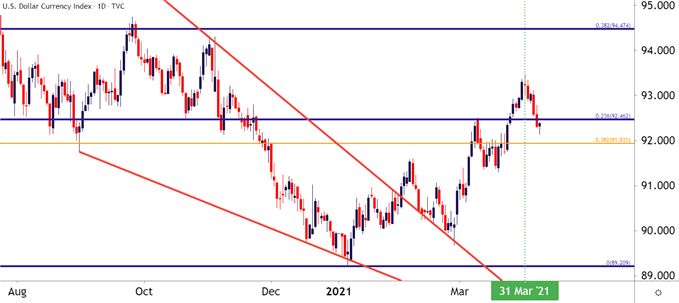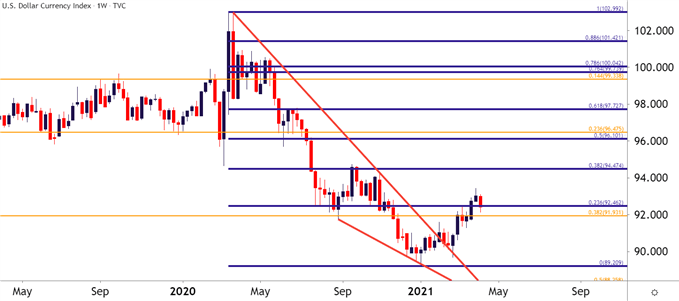US Dollar Talking Points:
- The US Dollar had a strong start to 2021, but was this but a pullback in a bigger-picture bearish theme?
- If USD bears are to prevail – they’ll likely need an assist from Euro bulls, and the European Union does not appear to be in a strong spot at the moment with lockdowns, Covid and a slower return of economic strength than what’s showing elsewhere.
- The analysis contained in article relies on price action and chart formations. To learn more about price action or chart patterns, check out our DailyFX Education section.
The US Dollar showed up with a surprising spate of strength in Q1 of this year, coming on the heels of a bleeding downtrend that dominated the currency’s final 8 months of 2020 trade.
But after going deep into oversold territory and as the DXY had formed into a falling wedge, often approached with the aim of bullish reversals, the stage was set for a Q1 counter-trend theme of US Dollar strength, and that scenario ran very visibly into the end of the quarter. At this point, the US Dollar has set a fresh four-month-high on the final day of Q1, after which sellers have started to push for a consistent move lower.
This goes in the direction of the bigger picture trend, the same that held strong through last year; but it also flies directly against the strength that was on full display in Q1.



US Dollar Daily Price Chart

Chart prepared by James Stanley; USD, DXY on Tradingview
Taking a step back to look at that bigger picture – and this puts that Q1 rally into scope. Price action in the USD did test above the 23.6% Fibonacci retracement of last year’s sell-off, but it wasn’t for long. And sellers have already pushed back below this key spot on the chart, keeping the door open for a return of the longer-term bearish trend.
To learn more about Fibonacci, check out the Fibonacci sub-module inside of DailyFX Education
US Dollar Weekly Price Chart

Chart prepared by James Stanley; USD, DXY on Tradingview
EUR/USD Bounce from Fibo Support
The US Dollar and DXY are highly sensitive to the Euro as the single currency makes up more than 57% of the allocation into DXY. So, suffice it to say, the US Dollar will often have a hard time going anywhere with at least some help from the Euro.
In this specific case, that premise seems as important as ever – as a re-emergence of USD-weakness will also likely need some Euro strength, and the EU isn’t exactly in a strong spot at the moment with lockdowns, Covid and a slower economic comeback than what’s being seen elsewhere.
In EUR/USD, the pair sold-off for much of Q1, eventually finding support at a key Fibonacci level around 1.1736. That’s so far led to a bounce in Q2 trade but, at this point, the trend still appears bearish and this keeps the door open for further downside focus in EUR/USD. What could begin to moderate that – potential resistance in the 1.1965-1.2000 zone, a breach of which would bring a much more bullish picture into the pair. This could expose a deeper drive towards the 1.2134-1.2167 area on the chart.



EUR/USD Daily Price Chart

Chart prepared by James Stanley; EURUSD on Tradingview
--- Written by James Stanley, Senior Strategist for DailyFX.com
Contact and follow James on Twitter: @JStanleyFX





